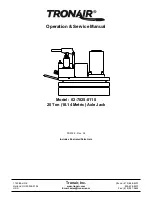
© by WilTec Wildanger Technik GmbH
Item 50795
Page 4
09 2021
-1
•
Avoid unsteadiness of the load.
•
Keep bystanders out of the path of the transmission jack.
•
Make sure to warn bystanders within the working area of lifted loads.
•
Never exceed the load capacity of the transmission jack.
•
Never use transmission jacks if they are damaged or malfunctioning in any way.
•
Never use retainers showing signs of damage or wear.
•
Do not lift loads if the lifting process could be obstructed by nearby objects.
•
Always make sure to stay focused and attentive when handling loads.
•
Do not abuse the transmission jack as ladder and do not lift individuals with it.
•
Do not lift objects over the heads of others.
•
Incorrectly secured or placed loads might cause damage to the device as well as its surround-
ings and even cause severe injuries or death.
•
Always keep an eye on lifted loads.
•
Ensure that the transmission jack does not bump into objects when being moved around.
•
Do not attempt to modify or repair the retainer of the transmission jack.
•
Do not use welding devices in the vicinity of the transmission jack.
•
Always make sure that your work place is well-lit and clean since cluttered and dark work areas
increase the risk of accidents.
•
Always make sure to wear non-skid safety shoes.
•
Do not wear loose clothing, scarves, necklaces and other accessories or unconfined long hair
when working with the transmission jack as they might get stuck in the device and cause severe
injuries.
•
Do not operate the transmission jack when you are tired or under the influence of alcohol, drugs
or medication.
•
Working while standing for a long time might cause dizziness. Ensure to regularly take breaks
and drink enough.
•
Do not abuse the transmission jack as car jack.
•
Only use the transmission jack on sturdy and even grounds in order for it to be capable of
utilising its maximum capacity.
•
Before working on a vehicle, ensure that the vehicle is properly secured and has been placed
accordingly.
•
Never loosen pressurised screws or bolts.
•
Make sure the load is placed in the centre of the retainer.
•
When refilling hydraulic oil, make sure that the retainer has been completely lowered. Only use
high-quality hydraulic oil and never use brake fluids, alcohol, glycerine, detergents, engine oil,
water, polluted oil or other liquids.
•
The hydraulic cylinder is exposed to constant pressure and must not be opened by force.
Control/inspection
•
Before operating the transmission jack, always visually check it for signs of damage or wear in
order to timely notice potentially loose or missing parts. Further make sure to regularly check
the oil level. Before refuelling oil, bring the retainer of the device into its lowest position. Then
remove the cover lid; the oil-level has to reach to the opening for the device to function properly.
•
If having been exposed to stronger impact forces or excess load, the transmission jack needs
to be checked for its integrity before it is used again. This examination should only be performed
by qualified personnel. It is further advised to have an inspection performed on an annual basis.
Defect parts need to be replaced immediately and the transmission jack must not be used before
its integrity has been restored. Therefore, regularly check the device for signs of cracks caused
by wear and corrosion. In case of corrosion, clean the affected area with an oily cloth.
•
In case of the transmission jack having to be scrapped, make sure to drain the oil beforehand
and to dispose of it in a proper and professional manner.

























